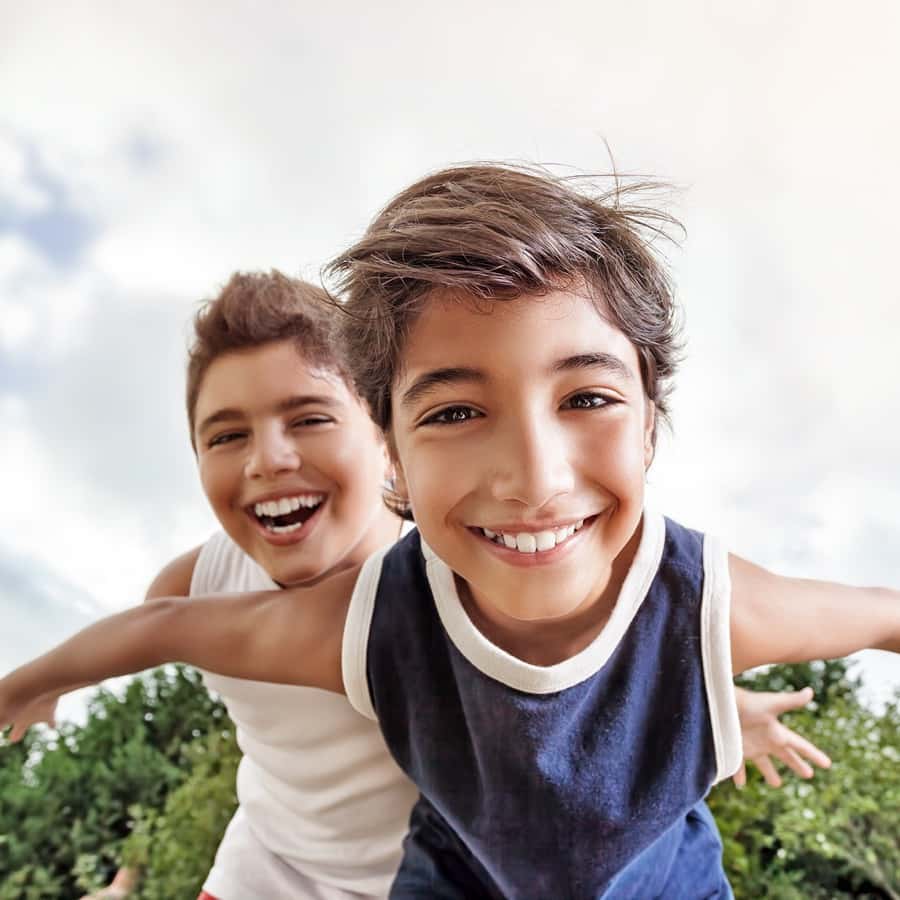
We’ve long suspected that children who spend more time playing outside are less likely to become nearsighted. That’s been shown in a number of studies summarized below. If we’d had any doubts, evidence from the COVID-19 pandemic lockdown dispelled them. Children who had to stay inside were far more likely to become nearsighted. Now, a study shows that youngsters with access to green space have better mental health.
Backyards, Parks and Woods for Kids:
Researchers conducting the Environmental Influences on Child Health Outcomes study assessed green space–backyards, parks or woods–where children might have a chance to play near their homes. They also used a Child Behavior Checklist to see if kids between 2 and 5 or those between 6 and 11 showed signs of mental health problems (JAMA Network Open, April 10, 2024). Their sample included more than 2,000 young people.
Children in the younger age group were significantly less likely to display behaviors indicating anxiety or depression if their homes were near green spaces. The researchers did not note any significant differences among the older children. They made statistical adjustments for socioeconomic status of the neighborhood because wealthier areas tend also to have more green space.
The investigators concluded:
“These findings suggest that green initiatives (eg, parks, urban forest programs, and protected natural areas) have the potential to reduce risk for early anxiety and depressive symptoms in children across the US. At a time of crisis in children’s mental health and dwindling natural environments, policies that protect and promote green space could have widespread benefits for children, society, and the environment.”
Does Playing Outside Benefit Vision?
According to a study of 5,700 Dutch youngsters who were followed from birth to age six, those who played outside had better eyesight (British Journal of Ophthalmology, Feb. 2018). The researchers analyzed multiple factors, including household income, parental education and children’s activities. When the kids were six they got a complete medical and eye exam. At that time, 137 of them (2.4%) were diagnosed with myopia.
What Was Different about the Nearsighted Youngsters?
These children had spent more time indoors and spent less time playing sports than the kids with normal vision. In addition, myopic children had lower vitamin D levels and higher body mass index. All of these factors could correlate pretty well with spending more time inside, away from the sun, in sedentary pursuits.
The authors conclude that environmental factors, especially playing outside, have an important impact of children’s vision.
Other Studies Agree That Time Outside Is Important:
This is not the first study to find that children who spend more time playing outside are less likely to become nearsighted. Primary school children who spent more time studying indoors developed longer eyes (Guo et al, PLOS One, April 27, 2017). The elongation of the eye is often associated with myopia.
A review of research found that, while time playing outside can prevent myopia, it cannot reverse the eye changes once they have occurred (Xiong et al, Acta Ophthalmologica, March 2, 2017). Japanese researchers found that violet light in the outdoor sunlight spectrum helps prevent nearsightedness (Torii et al, EBioMedicine, Feb. 2017).
Playing Outside at School:
A study in Barcelona also found that children who spent more time playing outside in green spaces were less likely to need glasses in three years (Dadvand et al, Environmental Research, Jan. 2017). One randomized controlled trial found that adding 40 minutes of recess to the primary school day reduced the number of students developing myopia over three years (He et al, JAMA, Sep. 15, 2015).
Children can also stay fit by playing outside. If they don’t have safe outdoor play spaces at home, they should be playing outside while at school.
Citations
- Towe-Goodman N et al, "Green space and internalizing or externalizing symptoms among children." JAMA Network Open, April 10, 2024. doi:10.1001/jamanetworkopen.2024.5742
- Tideman JWL et al, "Environmental factors explain socioeconomic prevalence differences in myopia in 6-year-old children." British Journal of Ophthalmology, Feb. 2018. DOI: 10.1136/bjophthalmol-2017-310292

